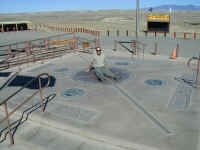Four Corners
We entered the Colorado portion of the Four Corners when we explored the ruins at Hovenweep NM. This area is home to over 4000 Ancient Puebloan sites. Many people are familiar with Mesa Verde National Park and the questions raised after visiting the ruins, such as "why did the people abandon all of their great cities?"
We are here to visit the adjacent sites located on the Ute Mountain Ute Reservation. The idea is to hear the stories of the Ancient Puebloans from an Indian perspective.
First though, we want to visit the highly recommended Anasazi Heritage Center (AHC). The center was built to house the three million artifacts recovered during the massive archaeological project that preceded the construction of a dam and the flooding of a large portion of the Dolores River Valley. The project, named the DAP, the Dolores Archaeological Program, was the largest single archaeological project in the history of the United States. Additionally, the Center is a focal point for the newly created Canyons of The Ancients National Monument. The Monument contains the highest known density of archaeological sites in the United States with sites spanning thousands of years.
Researchers identified about 1,600 archaeological sites just along the Dolores River in the project area. Imagine how many other sites must be in the area. Sites found included hunting camps, shrines, granaries, households and entire villages. The researchers were able to excavate or test 120 sites before the dam and the new reservoir would destroy them.
The exhibits at the AHC include hands-on exhibits, interactive computer programs and even a reconstruction of an actual pithouse that was excavated during the DAP. On site are the remains of two additional villages built during the 1100ís.
After the AHC we headed off to the Ute Mountain Tribal Park. But unfortunately bad luck awaited us. When we arrived at the Ute Tribal Park office to arrange for a guide to visit the ruins, we found the office locked up tight. All our information, including the Ute Tribal Park web site and their brochure indicated that the office was open every day of the week. We backtracked to a group of businesses operated on the Ute Reservation to ask for help. The people there were very helpful, even calling some of the guidesí homes. But it turned out that since there wasnít very much business, the guides had closed the office and apparently gone out of town. Oh no! We were told that if we came back in a few days we might be able to hire a guide. Our plans donít give us this much freedom, so we sadly have to miss out on this adventure.
On our earlier visit to the Anasazi Heritage Center we reviewed a map of the Canyon of The Ancients in NM. We decided it was time to add a new adventure to our expedition and go in search of our own ruins. Our drive out of town took us along the McElmo River looking for a suitable canyon to begin our search. We found a likely candidate in Yellow Jacket Canyon.
At the old and apparently abandoned Ismay Trading Post we started our adventure. Almost immediately Kim shouted that there were petroglyphs on a boulder above the trail. What we found are likely the best rock art weíve ever found on our own. (See Panorama Page) The petroglyphs were various styles that dated back several thousand years, and our "discovery" was about to get even better.
We decided to climb to the top of the hill to survey the surrounding area in hopes of finding a mound containing ruined buildings. As we made our way around the boulder we found evidence of rock walls. Our first thought was that we had found the site of shamanist or religious import. This thought quickly vanished as we found more walls, pottery sherds and even stone tools. We had discovered an entire unexcavated village! We named it Kim & Donís Site.
Whenever exploring rock art or ruins, it is always important to respect the site. Many of these places are still considered sacred to local tribes. Also, it is OK to look but not to remove anything. Every item that we picked up we put back in the same place it was found. By moving artifacts we would make it difficult, if not impossible, for a researcher to discover the story the artifact could tell us. Donít touch rock art or attempt to reproduce it by doing rubbings. (See how you can protect all sites.)
| From here we are heading to Chaco Canyon National Historical Park, but first we made a quick stop at the Four Corners Monument. This is the only spot where you can stand in four states at the same time. In my case I sat. |
